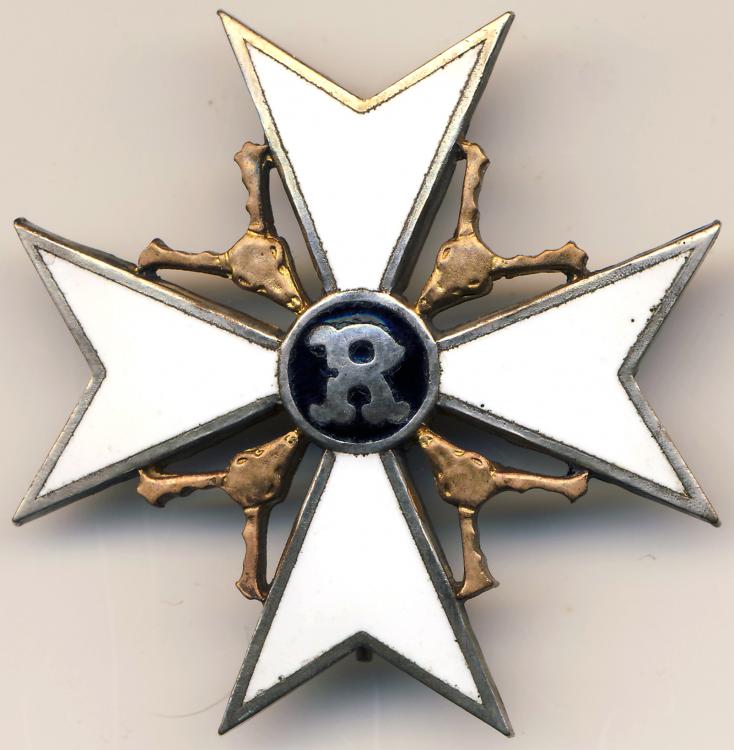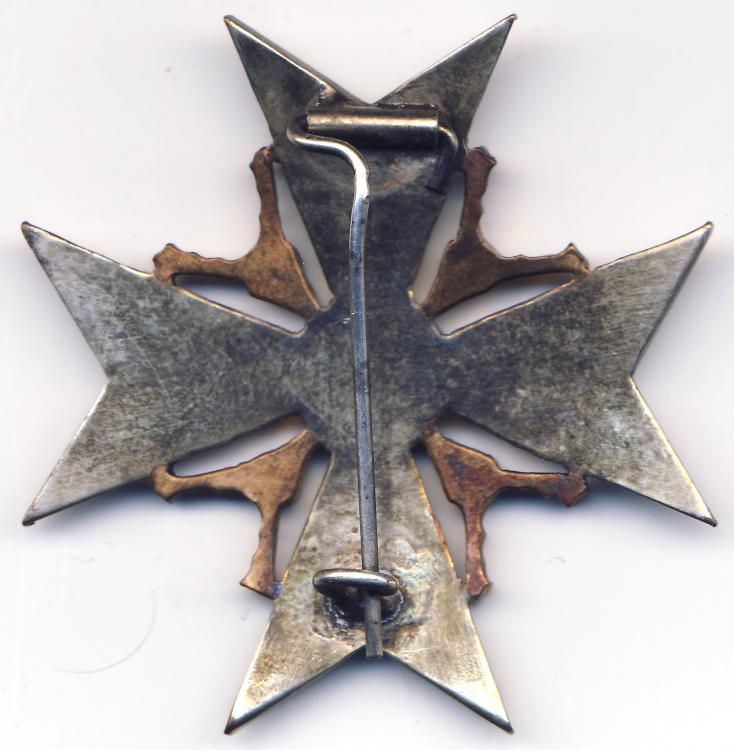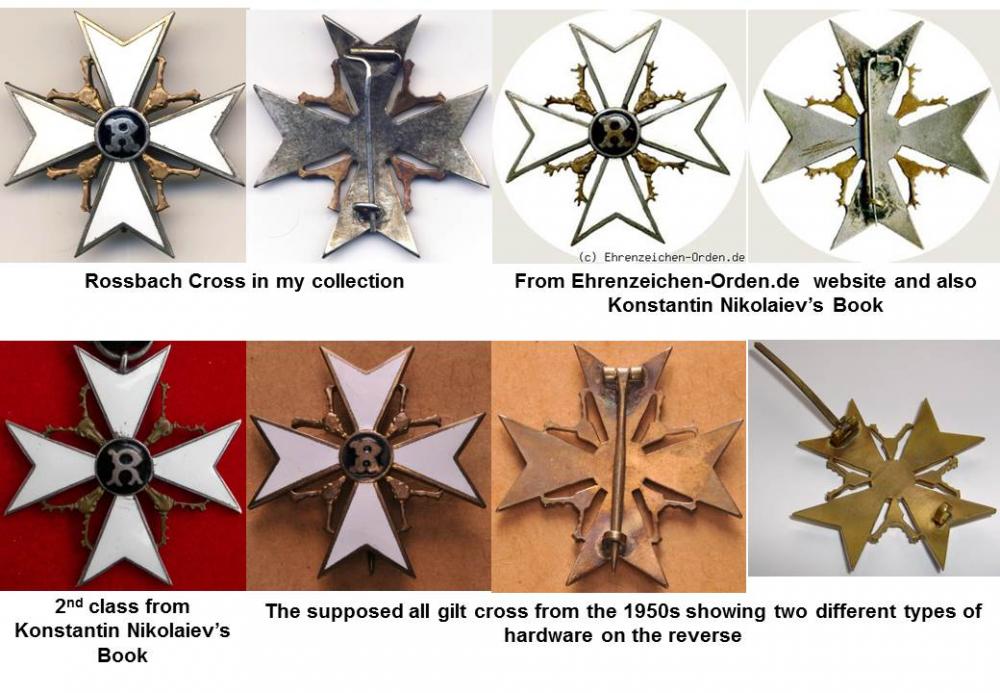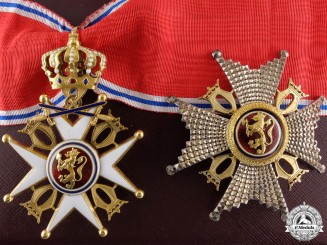
bolewts58
-
Posts
603 -
Joined
-
Last visited
-
Days Won
9
Content Type
Profiles
Forums
Blogs
Gallery
Events
Store
Posts posted by bolewts58
-
-
I saw this on eMedals. It's a beautiful award and nice to have the case. Congrats.
But, the case has a GA Scharffenberg label. Yet, the cross is marked 'R' which is Alfred Rösner, Dresden. So, the cross and case were likely not originally together, unless the original recipient picked up a replacement case from GA Scharffenberg, which seems unlikely.
I don't think it diminishes the value, really. Cases for this order are hard to get. But, still I wanted to point out the discrepancy.
0 -
As far as I know this is a Weimar Era Deutsches Reiter-Verdienstkreuz and differs from the 1969 version as the arms were pebbled and followed the familiar pattern of the iron cross as seen in the close-up and also had the letter 'R' at the base of the wreath. As with the post-45 Reiterabzeichen, the 'R' was omitted on the 1969 cross. The only one I have ever had in-hand was silver and made by Steinhauer u. Luck. But, they came in bronze, silver and gold.
If you look at post 138 and 139 in this link, you'll see what appears to be a gold version of the cross.
http://gmic.co.uk/topic/15277-post-your-r-reiterabzeichen-and-r-fahrerabzeichen/?page=6
0 -
Thanks Mike. While I accept Sergey's assessment of this cross, I'm not prepared to declare it an outright fake. At the moment, it seems to be a one-off, from what date, I don't know. I realize that it's certainly not Freikorps period. Sergey's correct that it's details match what I have called the post-1945 Rossbach-sanctioned re-issues (based on what I consider fairly valid info from a very reliable source). But, it is made of "Neusilber" (white metal alloy) rather than the usual bronze gilt seen on these post '45 crosses. So, it's a bit of a head-scratcher, at this point. I will likely try to sell it, at some point. But, I'll identify it as a later manufactured anomaly, unless some new information comes to light that definitively identifies it as a fake.
0 -
I can't argue against your evidence, as you have more experience with this cross than I do. I will say that the one thing about mine that bothers me, particularly are the stag heads, especially the antlers.
The quality of the seller's Freikorps badges is very high. But, almost all his items are fake. I have been able to spot most of the fakes, because of experience with real items. But, I hadn't seen genuine examples of this cross other than in photos. So, I took a chance.
The seller with the ID of porre81 changed his identity to adlernest01 and then again resurfaced as vanderbilt4392. This slippery cheat and fraud is to be avoided at all costs. Subsequently, he deleted his profile on eBay. I did manage to open a case and request a refund. He rejected the refund request and eBay Germany, useless scumbags that they are, accepted his rejection and closed the case. I learned long ago, as both a buyer and seller on eBay Germany, that it does not have the same level of whatever integrity the parent company in the US has and that eBay Germany plays favorites and is often downright corrupt.
The real name and address of this seller of high-quality fake Imperial, Freikorps and Third Reich items is:
Marc Poredda
Gustav-Heinemann-Str. 45
58239 Schwerte
Deutschland
This whole experience has been a hard lesson learned and a blow to my credibility, more so I think because it happens rarely. But, when it does, it happens in a spectacular fashion. But, it's taught me to go with my gut, rather than taking a chance on spec.
0 -
16 hours ago, Deruelle said:
Hi
I am impressed by the quality of your collection. Congrats.
When I've begun to collect Militaria, the first book I have bought is the von Salomon's Freikorps book from 1938. At that time I'd loved to collect freecorps medals but I have never found one in militaria show. Later I have found some dealers who sold some but there is a lot of fake. So I have chosen to collect Imperial medals.
Thanks for sharing your collection with us.
Christophe
I understand your caution about Freikorps fakes. But, there are comparatively few of them, when compared to the large numbers of fake Imperial German orders, decorations and badges.
0 -
Freikorps collecting is often frustrating because of the often incomplete records, sometimes anecdotal information and scarcity of period examples of awards and badges with which to compare. A case in point is the Rossbach Cross of Military Merit.
I have one of these in my collection and while I have a great deal of confidence in it because of the quality of manufacture, how it compares to other Freikorps awards and that it conforms in many ways to what is known about the award, there's no definitive way to say absolutely that it is genuine simply because there are so few examples around to use for comparison. I suppose that alone is actually a positive, as there don't seem to be fakes of this anywhere on the market because you simply hardly see this cross in any form.
Most of what is known about this award is second hand, coming as it does from Klietmann who received rather spotty information about the cross from Rossbach sometime in the 1950s.
What is known is this.
Rossbach conceived of the cross in late 1919 as a combattant award for members of his Freikorps. Sample designs were created at the beginning of 1920 by two firms: Friedrich Sedlatzek and J. Godet & Sohn. The cross was around 51mm silvered white metal alloy with gilded stag heads between the white-enameled arms and 12mm center medallion in black enamel with a silvered letter 'R'. It had an unusual round needle pin which passed through a barrel hinge and was bent to form a crude tension spring. This style of hardware is only seen on a few Freikorps period awards and nowhere else.
A lack of funds prevented an order being made until Spring 1921. Award certificates only were first handed out in May 1921. It's assumed that recipients had to buy the cross themselves. The number of awards from this ceremony is unknown. Which manufacturer chosen for production is also unknown and all known pieces are unmarked. In my opinion, it's probable that both makers made crosses to order for recipients, since the test dies already existed. Variations of the cross are known. So, this seems likely.
Several additional crosses were apparently awarded to members of the Freikorps who participated in the Beer Hall Putsch in 1923. The last awards were made at a dedication ceremony of the old Rossbach battle flags to the S.A. on November 6, 1933. According to Klietmann, Rossbach indicated that he thought no more than 120 formal awards were handed out. A special version of the cross was awarded to General, Prince Pavel Bermondt-Avalov.
There was also a 2nd class awarded which is even rarer than the 1st class.
Additional anecdotal information that I got from a well-known collector many years ago, who claimed to have been told this by Klietmann was that Rossbach had another lot of crosses produced in the late 1950s made of tombac and only with a gilt finish (rather than the silvered alloy with gilded stags on the originally ordered crosses) and with post-1945 hardware on the reverse. These were supposedly given to special business acquaintances of Rossbach's, who had at that time a very successful import-export business. This post-1945 cross was apparently also given out at the 40 year reunion of the Freikorps in 1961. There are very few of even these post-45 crosses around. Klietmann supposedly referred to them as "Nachfertigungen", which could translate as replica or reproduction, but I think is meant to mean a subsequent production or re-issue. Since Klietmann was running Godet at this point, he could well have been the producer of this "second run" of the cross.
Excluding the post-1945 cross, I've identified 4 variations in known 1st and 2nd class crosses, including mine, which is similar to the one shown in Hartung's book, except with different hardware.
Here is an image of mine and also a comparison with others that are known.
0 -
-
I think there's zero chance to find his identity because he's just an ordinary soldier. Even if he was an officer, there would only be a slight chance, unless he was a famous leader. Freikorps records are very spotty at best.
0 -
I don't dispute that this is a Freikorps Grenzschutz MG unit which happens to have the name Berthold. But, it isn't the same as Detachment Berthold (more correctly Eiserne Schar Berthold) which wasn't formed until April 1919 by ace Rudolph Berthold.
At the time of this photo, Berthold was at home convalescing from a plane crash in August 1918.
0 -
I believe this is the case. I've seen a number of post 1918 awards to soldiers with no combat experience during the war, but with extensive Freikorps period experience. However, I believe that many of these recipients tended to be members of the regular army/Reichswehr and not the more unofficial Freikorps units, unless those units were attached to and later absorbed into the Reichswehr.
0 -
That's a nice Militärpass. Freiwillige Schutztruppe Wilhelmshaven is a scarce unit.
0 -
On 10/24/2016 at 03:56, Gilles said:
Could be Freikorps, compare with the badge of the "Freie Nachrichten-Truppen" shown in Ingo Haarcke's reference book #621.1 page 106
Gilles is correct. It's Freie Nachrichten-Truppen.
0 -
I just picked up a Militärpass and Soldbuch to a Sturm-Soldat. He served in the Sturm Abteilung der 207 ID and then in the Sturm Kompagnie der 89 Reserve Infanterie-Brigade. He also served in a Freikorps Grenzschutz Ost company and won the EKI, II and Grenzschutz Ost Deutsch-Ritterkreuz. Here is the front page of his Soldbuch. I will post both pieces when I get them.
Does anyone have any information on these two Sturm units?
0 -
That's a very interesting and rare badge.
0 -
The middle photo is of Kaiser Wilhelm I.
0 -
1 hour ago, dante said:
Excellent and many thanks, I have also confirm his service on the Bavarian state archives on Ancestry, guess my question is, would you class these units as "Freikorps" or traditional "Border Guards" given their location on the Czech border
Strictly speaking, it's not a Freikorps as it wasn't formed by Heiss, himself, but by the Reichswehr Oberkommando in Bavaria, with Heiss as an army captain being given its command. But, as it served during the Freikorps period, it falls into the realm of Freikorps and Freikorps collecting, much in the same way that Einwohnerwehren (Civil Defense Militias) fall under the umbrella of the Freikorps period, even though they were mostly government organized units.
0 -
9 hours ago, dante said:
I have the chance of a WW1 Bavarian pass to Grenzschutzbataillon Heiss and Grenzschutzkommando Schönsee, cannot find any details on these units, welcome any thoughts, information
Grenzschutzkommando Schönsee was the district headquarters of the border defense forces in Bavaria near the Czechoslovakian border from December 1918 until June 1919. Grenzschutzbataillon Heiss was commanded by Hauptmann Adolf Heiss, who joined the Bavarian Army in 1903, served in WWII and was made commander of Grenzschutzbataillon Heiss in December 1918. Grenzschutzbataillon Heiss became part of the Reichswehr in June 1919 and was garrisoned in Nürnberg as "Heimatschutzbataillon Heiss" as a security force when workers demonstrated on March 17, 1920 during the Kapp-Lüttwitz Putsch.
On October 11, 1920, Hauptmann Heiss transformed Heimatschutzbataillon Heiss into the paramilitary group, "Wehrverband Reichsflagge", which eventually reached a strength of 20,000. Heiss was pensioned from the Reichswehr in 1923. Heiss merged Wehrverband Reichsflagge with the Stahlhelm in 1927, when he was reactivated as a Major in the Reichswehr. Heiss was promoted to Oberstleutnant in 1939 and to Oberst in 1942. He was MIA on the Eastern front near Posen in January 1945.
0 -
18 hours ago, Tony said:
Besides, ebay is usually on the side of the buyer
That's not been my experience and I both buy and sell on eBay Germany. I have had a number of disputes and it's my experience that eBay Germany favors certain sellers over others and overall rarely helps buyers. I have complained to the parent company in the US a number of times, about the nefarious practices of eBay Germany. But, they claim they have little to no authority over subsidiary branches of the company.
IMO, eBay Germany is disreputable and it is very much "buyer beware" (and sometimes seller beware, as well) when dealing with them.
I'm sorry Chris that you've been put through this. It's bad enough being ripped off by a seller. But, when the company doesn't really provide any recourse, it's particularly hard to take.
0 -
Its not Sütterlin, but Kurrentschrift. Sütterlin was a modernized, simplified form of Kurrentschrift, only introduced into German schools in 1915 and which didn't enter wide use until the late 20s. It was taught as the primary handwriting form until 1941 until banned by the Nazis. It was re-introduced after the war as a secondary cursive form (Latin cursive being the primary) and taught in some parts of Germany until the 1970s.
0 -
The writing is all Kurrenschrift and I think contemporary to the period, although quite sloppy, even if it was embellished a bit by someone or the guy himself. Kurrentschrift is difficult to do and is pretty much a lost art, today. I'm sure there are people who still know how to write this way. But, it's not so common.
But as far as the awards go, whether an observer or ground crew, he still would have gotten the Silesian Eagle I and II, based on service in FA409.
Also, Gunnar, I wasn't attacking you. I was just reacting to your original statement which had no explanation. Now that you've explained in some detail, you raise a number of very valid points.
0 -
of course the more opinions the better...So, maybe not definitive, but with believable evidence.
Chris you have a point. The awards after the EKII look as if they were added later by another hand. This doesn't bother me too much. They could have just been an addendum of missing information. The Grenzschutz-Flieger Abteilung 409 stamp looks correct to me and I do know what they are supposed to look like. Honestly, there aren't too many people around who know what these stamps look like to try to fake them. But, it would be good to have it in hand to examine everything.
The one thing that does bother me is all the ink staining at the bottom.
If there are some issues, it seems odd to me that anyone would tamper with or outright fake a Stammrolle. They're not worth all that much (even this one) compared to the work involved.
0 -
8 hours ago, Soderbaum said:
Hi
I actually have some doubts about this document. It is possible that everything written there could be "wrong".
just some thoughts
Gunnar
You make a reckless statement like that, but don't provide one bit of evidence. The information on the document fits the historical record, is logical and as far as I'm concerned it's 100% genuine. So, what (if anything) is your proof? It better be pretty definitive.
0 -
IMO a genuine cross in 14k gold (585 is the European mark for 14k meaning 58.5% gold).
0 -
2 minutes ago, dante said:
Bryan your comment " I'm not sure what more you hoped to find out by posting it here" is because it is post 1918, and having done so have received a lot more interest both public and private...it also gives those who are solely interested in Freikorps an opportunity to see the document
Its not only about what we gain, but about sharing, which you have have done most successfully on this forum and others...
I didn't mean it wasn't worth sharing. I really appreciate seeing it. I wish it was mine as I collect anything to do with Freikorps flying units. I only meant that I'm not sure what more you can learn here. It deserves research beyond this forum. By the way, Grenzschutz FA 409 also served in the Baltic in 1919. But, there's no indication here that Bothke went with them when they transferred to Riga from Silesia.
0






Freikorps Insignia
in Germany: Weimar Republic & Deutsche Freikorps
Posted · Edited by bolewts58
I think it's Verband Badische Jäger. It's not Freikorps and doesn't belong on this thread.